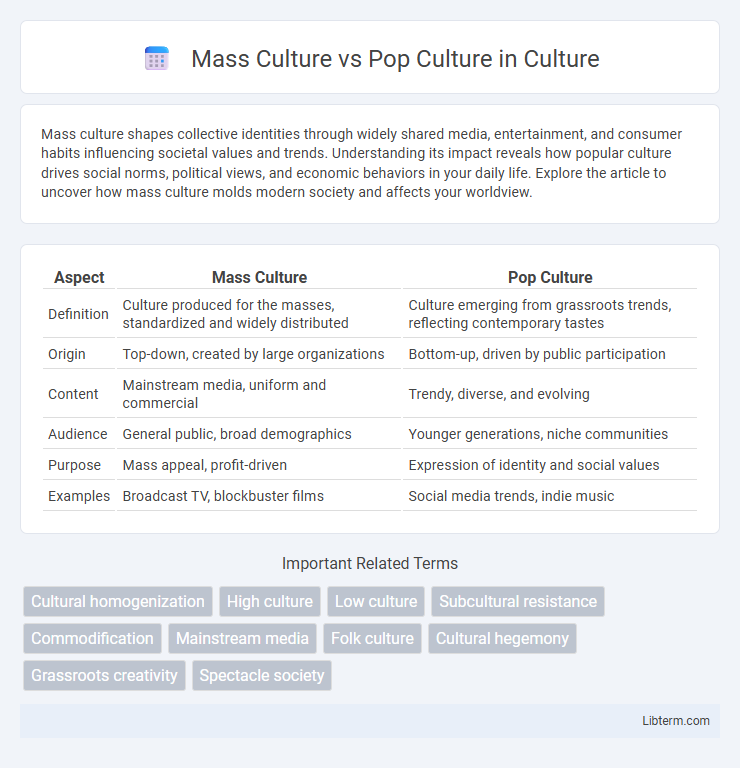Mass culture shapes collective identities through widely shared media, entertainment, and consumer habits influencing societal values and trends. Understanding its impact reveals how popular culture drives social norms, political views, and economic behaviors in your daily life. Explore the article to uncover how mass culture molds modern society and affects your worldview.
Table of Comparison
| Aspect | Mass Culture | Pop Culture |
|---|---|---|
| Definition | Culture produced for the masses, standardized and widely distributed | Culture emerging from grassroots trends, reflecting contemporary tastes |
| Origin | Top-down, created by large organizations | Bottom-up, driven by public participation |
| Content | Mainstream media, uniform and commercial | Trendy, diverse, and evolving |
| Audience | General public, broad demographics | Younger generations, niche communities |
| Purpose | Mass appeal, profit-driven | Expression of identity and social values |
| Examples | Broadcast TV, blockbuster films | Social media trends, indie music |
Defining Mass Culture and Pop Culture
Mass culture refers to cultural products and experiences created and distributed on a large scale, often standardized to appeal to broad audiences through mass media and commercial channels. Pop culture, or popular culture, consists of trends, entertainment, and practices that emerge organically within a society, reflecting the tastes and identities of diverse social groups. While mass culture emphasizes widespread consumption and homogenization, pop culture highlights dynamic, grassroots expressions that evolve rapidly across demographics.
Historical Origins of Mass and Pop Culture
Mass culture originated in the industrial revolution era, characterized by the rise of mass production, urbanization, and widespread literacy, which enabled standardized cultural products distributed to large audiences. Pop culture emerged later in the 20th century, rooted in youth culture and media industries, reflecting more dynamic, diverse, and commercialized expressions influenced by television, music, and digital technologies. The historical distinction lies in mass culture's role in unifying large populations through uniform cultural experiences, whereas pop culture emphasizes individuality, trends, and rapid evolution.
Key Characteristics of Mass Culture
Mass culture is characterized by its standardized, commercialized nature aimed at a broad audience through mass media such as television, radio, and print, promoting uniformity and consumerism. It often emphasizes passive consumption, reinforcing dominant societal values and limiting individual expression. Unlike pop culture, mass culture prioritizes mass production and widespread dissemination over niche or grassroots creativity.
Key Characteristics of Pop Culture
Pop culture is characterized by its widespread appeal, accessibility, and constant evolution, driven by mass media, music, television, and social platforms. It reflects contemporary societal values, trends, and issues, often blending various cultural elements to create easily recognizable symbols and practices. Pop culture fosters a sense of community and identity through shared experiences and rapidly changing tastes.
Influence of Technology on Cultural Forms
Mass culture and pop culture have both evolved through the profound influence of technology, shaping the way audiences engage with media and entertainment. Innovations such as television, the internet, and social media platforms enable rapid dissemination and consumption of cultural content, transforming passive mass culture into interactive pop culture experiences. Digital technology accelerates trends and fosters global cultural exchanges, intensifying the fluid and dynamic nature of contemporary cultural forms.
Role of Media in Shaping Culture
Mass culture and pop culture are both shaped significantly by media, but their influence varies in scope and approach. Mass culture, often associated with standardized and homogenized content, is disseminated through traditional mass media channels like television and newspapers that target broad audiences. In contrast, pop culture evolves dynamically through diverse media platforms, including social media and streaming services, enabling interactive engagement and the rapid spread of trends among specific demographic groups.
Consumerism and Cultural Production
Mass culture primarily reflects consumerism through standardized cultural products designed for broad audiences, emphasizing passive consumption and commercial profitability. Pop culture, in contrast, fosters dynamic cultural production by blending diverse influences and encouraging active participation, creativity, and subcultural expression. The relationship between these forms highlights tensions between homogenized market-driven content and grassroots innovation within contemporary cultural landscapes.
Globalization’s Impact on Mass and Pop Culture
Globalization has accelerated the diffusion of mass culture by spreading standardized media, consumer products, and entertainment across international markets, often overshadowing local traditions. Pop culture thrives as a dynamic, hybrid phenomenon shaped by global connectivity, enabling diverse cultural expressions through digital platforms and social media. The interplay between global mass culture and localized pop culture fosters cultural exchange but also raises concerns about cultural homogenization and the preservation of unique identities.
Cultural Criticism and Social Implications
Mass culture often faces criticism for promoting homogeneity and passive consumption, diluting diverse cultural expressions and reinforcing dominant ideologies. Pop culture, while more dynamic and consumer-driven, can both challenge and perpetuate social norms, reflecting and shaping identity politics and collective values. The social implications of these cultures include influencing social cohesion, identity formation, and power relations within society.
Future Trends: Evolving Boundaries between Mass and Pop Culture
Future trends indicate a growing convergence between mass culture and pop culture driven by digital media platforms that blur traditional consumption boundaries. Interactive technologies and personalized content algorithms enable niche pop culture elements to gain mass appeal, fostering hybrid cultural experiences. As globalization and virtual communities expand, cultural production becomes more decentralized, challenging the dominance of mass media and reshaping cultural identities.
Mass Culture Infographic

 libterm.com
libterm.com